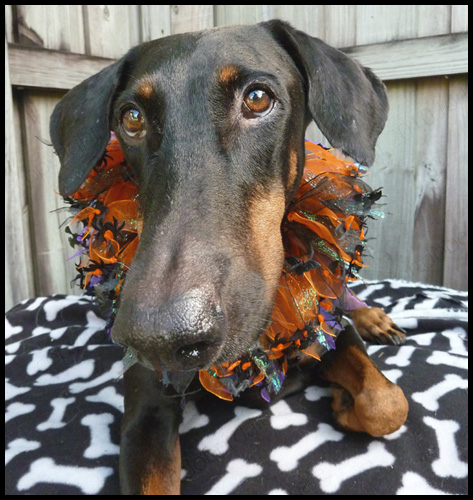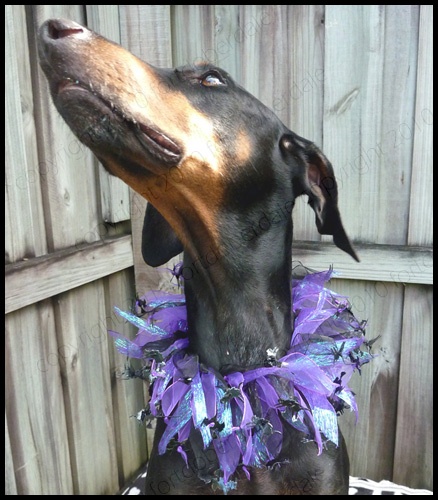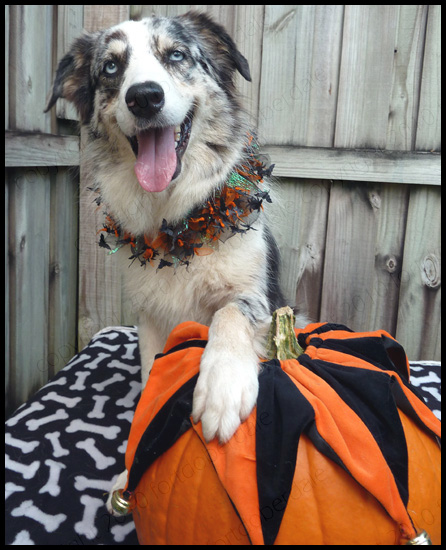 It’s Halloween eve, time of zombies, gremlins, and other scary stuff. So I thought I’d expand a little more on yesterday’s post, Clicking, and the fear of cameras that some dogs develop.
It’s Halloween eve, time of zombies, gremlins, and other scary stuff. So I thought I’d expand a little more on yesterday’s post, Clicking, and the fear of cameras that some dogs develop.
As I mentioned, the best way to dodge installing the fear of a camera into a dog is to avoid using the flash in his direction or pointing a camera too close to him before training him to accept it. If the camera’s aversive to him, then he’s going to run and hide every time the camera comes out, and there goes your Kodak moments. Or does it?
 Once a dog is shy or fearful of the camera, there are ways to turn it around, but let me say, it’s much easier not to create the fear in the first place. But if the fear of the camera and the dog have met, the first step is is not to force the camera on him once he shows signs of fear. If you do, that will make his fearful reaction worse. Think about if from your perspective.
Once a dog is shy or fearful of the camera, there are ways to turn it around, but let me say, it’s much easier not to create the fear in the first place. But if the fear of the camera and the dog have met, the first step is is not to force the camera on him once he shows signs of fear. If you do, that will make his fearful reaction worse. Think about if from your perspective.
Imagine something that frightens you. Fear of heights? Giving a speech to a large audience? Stepping into your yard barefoot and feeling a snake slithering over your toes? Fear of flying? I’m sure something pops into your mind.
 We all have fears. They’re debilitating and a couple of the worst things we can do to someone who has a fear, whether animal or human, is to force them to face it. Forcing someone to go over the threshold their capable of is inhumane and counterproductive. If you’re afraid of flying, and a couple of people drag you onto an airplane, strap you in, and take off commences, there’s no telling how you’ll react when the panic in you takes over.
We all have fears. They’re debilitating and a couple of the worst things we can do to someone who has a fear, whether animal or human, is to force them to face it. Forcing someone to go over the threshold their capable of is inhumane and counterproductive. If you’re afraid of flying, and a couple of people drag you onto an airplane, strap you in, and take off commences, there’s no telling how you’ll react when the panic in you takes over.
Or if your afraid of heights and someone drags you up to the top of a high rise building and forces you out to the ledge of the roof to prove there’s nothing to be afraid of, are you going to be rational? My hands are sweating just thinking about it. Forcing someone to get over a fear doesn’t help the cause, and in fact, will create distrust by the one who’s been forced to whomever is doing the forcing. The fear will become more intense after force, as well, than what was there to started with.
 Fear can be dealt with and worked through calmly, humanely, and systematically. Fear in dogs is a behavior that can be addressed and the dog’s quality of life improved. If you have a fearful dog, and need help, contact me. I’ll apply behaviorally scientific methods, proven processes, that will help you and your dog. Because having a fearful dog is mortifying for the owner and debilitating for the dog.
Fear can be dealt with and worked through calmly, humanely, and systematically. Fear in dogs is a behavior that can be addressed and the dog’s quality of life improved. If you have a fearful dog, and need help, contact me. I’ll apply behaviorally scientific methods, proven processes, that will help you and your dog. Because having a fearful dog is mortifying for the owner and debilitating for the dog.
By Helen Verte
Certified Pet Dog Trainer-Knowledge Assessed, Certified Trick Dog Instructor
Broward County Behavior Modification
